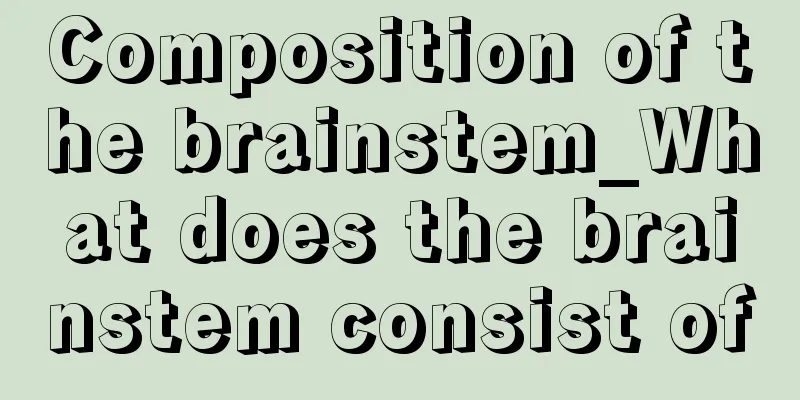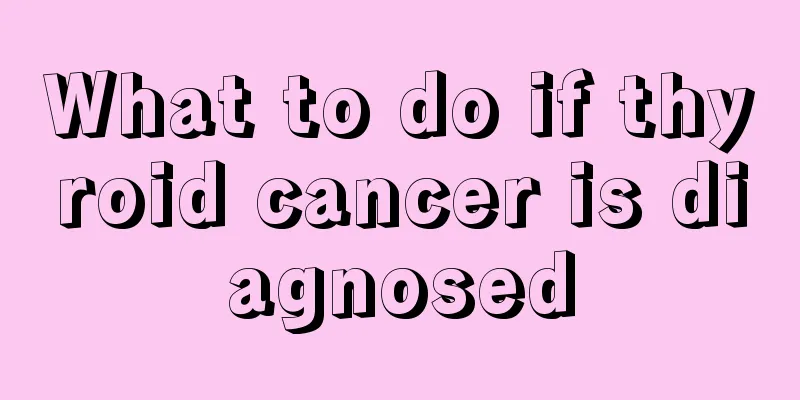Composition of the brainstem_What does the brainstem consist of

|
The structure of the human brain is relatively complex, because many of people's abilities rely on the control of the brain. Therefore, once a brain disease occurs, it should be treated promptly, otherwise serious consequences may occur, such as being life-threatening. However, we should understand the composition and structure of the brain so that we can promptly identify where the problem occurs after we become ill. What does the brainstem consist of? The shape of the brainstem Ventral brain stem When viewed from the ventral side of the brainstem, there are left and right crossing fibers at the median fissure of the medulla oblongata, called the pyramidal decussation, which is the boundary between the medulla oblongata and the spinal cord. The longitudinal protrusions on both sides of the median fissure are cones formed by the corticospinal tract (or pyramidal tract). The lower end of the pons is separated from the medulla oblongata by the ponto-medullary sulcus, and the upper end is connected to the cerebral peduncle of the midbrain. 1. The appearance of the medulla oblongata: between the foramen magnum and the medullary pontine sulcus. There are pyramids, pyramidal decussation, olives, hypoglossal nerve roots, glossopharyngeal nerves, vagus nerves, and accessory nerves. 2. The appearance of the pons: the pons base, pontine basal sulcus, pontine arms, trigeminal nerve roots, abducens nerve, facial nerve, vestibulocochlear nerve, and pontocerebellar angle. 3. The appearance of the midbrain: It is separated from the diencephalon by the optic tract and contains the cerebral peduncles, interpeduncular fossa, and oculomotor nerve. Dorsal surface of brainstem The medulla oblongata can be divided into two sections: upper and lower. The lower section is called the closed part, and its ventricular cavity is the continuation of the central canal of the spinal cord. On both sides of the median sulcus are the gracile tubercle and the cuneate tubercle, in which the gracile nucleus and cuneate nucleus are hidden, respectively. The dorsal surface of the pons forms the upper half of the floor of the fourth ventricle. There is a transverse medullary striae at the bottom of the fourth ventricle, which marks the boundary between the medulla oblongata and the pons. 1. Medulla oblongata and pons: floor of the fourth ventricle, rhombencephalic isthmus, left and right superior cerebellar peduncles, anterior and posterior medullary velum, trochlear nerve 2. Rhomboid fossa: the floor of the fourth ventricle. The lower limit of the rhomboid fossa: the gracile fasciculus, tubercle of the cuneate fasciculus, and inferior cerebellar peduncle. Upper boundary: superior cerebellar peduncle. Bilateral corners: lateral recess of the fourth ventricle. Medullary stria, terminal sulcus, medial eminence, facial hillock, locus coeruleus, lateral area, vestibular area, auditory tubercle, hypoglossal triangle, vagus triangle. 3. The shape of the midbrain: tectum, superior and inferior colliculi, and superior and inferior colliculi arms. Brainstem structure The brain stem includes the following four important structures: 1. Medulla The medulla is located in the lowest part of the brain and is connected to the spinal cord; its main function is to control breathing, heartbeat, digestion, etc. Controls breathing, excretion, swallowing, gastrointestinal and other activities. 2. Pons The pons is located between the midbrain and medulla oblongata. The white matter nerve fibers of the pons reach the cerebellar cortex, which can transmit nerve impulses from one hemisphere of the cerebellum to the other, enabling it to coordinate muscle activities on both sides of the body and regulate and control human sleep. 3. Midbrain The midbrain is located above the pons and is exactly the midpoint of the entire brain. The midbrain is the reflex center of vision and hearing. All activities of the pupils, eyeballs, muscles, etc. are controlled by the midbrain. 4. Reticular system: The reticular system is located in the center of the brainstem and is a reticular structure composed of many complex collections of neurons. The main function of the reticular system is to control different levels of consciousness, such as wakefulness, attention, and sleep. Internal structure The arrangement pattern of brainstem nerve nuclei, from the inner side to the outer side of the sulcus terminalis: General somatic motor nucleus, special visceral motor nucleus (migrated ventrally), general visceral motor nucleus, general visceral sensory nucleus, special visceral sensory nucleus, general somatic sensory nucleus (migrated ventrolaterally), and special somatic sensory nucleus. 1. General somatic motor nuclei: Oculomotor nucleus: innervates the levator palpebrae superioris, superior rectus, medial rectus, inferior oblique, and inferior rectus muscles. Trochlear nerve nucleus: crosses out of the brain and innervates the superior oblique muscles. Abducens nucleus: lateral rectus muscle. Hypoglossal nucleus: internal and external tongue muscles. 2. Special visceral motor nuclei (migrated ventrally) Motor nuclei of the trigeminal nerve: muscles of mastication, mylohyoid, digastric, anterior belly. Facial nerve nucleus: innervates all facial muscles, including the posterior belly of the digastric muscle, the stylohyoidal muscle, and the stylohyoid muscle. Dorsal nucleus: Frontalis muscle, orbicularis oculi muscle. Ventral nucleus: perioral muscles. Nucleus ambiguus: Fibers join the glossopharyngeal vagus accessory nerve to innervate the pharyngeal muscles. Accessory nerve nucleus: It sends fibers to form the accessory nerve spinal root, which innervates the sternocleidomastoid and trapezius muscles. 3. General visceral motor nuclei Accessory nucleus of the oculomotor nerve: dilator pupil, ciliary muscle. Superior salivatory nucleus: Fibers join the facial nerve to innervate the lacrimal gland, sublingual gland, submandibular gland, and glands of the oral and nasal cavities. Inferior salivatory nucleus: Fibers join the glossopharyngeal nerve through the otic ganglion to control the secretion of the parotid gland. Dorsal nucleus of the vagus nerve: Fibers pass through the vagus nerve and exchange neurons in the organs and paraganglia - postganglionic fibers manage the movement and secretion of visceral smooth muscles, myocardium, and glands in the thoracic and abdominal cavity. 4. General visceral sensory nucleus. Nucleus of the solitary tract: The general visceral sensation of the mucosal vascular walls of the visceral organs---glossopharyngeal vagus nerve---solitary tract---nucleus of the solitary tract---sends fibers to ascend to the diencephalon, and after relaying, reach higher centers. Brainstem motor nuclei: involved in visceral reflexes, reticular formation, involved in respiratory circulation and vomiting reflex. 5. Special visceral sensory nuclei. Dorsal part of the nucleus tractus solitarius: receives taste fibers from the glossopharyngeal nerve and facial nerve. 6. General somatosensory nucleus (migrated ventrolaterally) Trigeminal nucleus. Spinal nucleus of the trigeminal nerve: pain, temperature and touch sensation in the frontal, facial, nasal and oral mucosa. Trigeminal sensory nucleus: touch and pressure sensation in the frontal, facial, nasal and oral regions. Midbrain nucleus of the trigeminal nerve: related to proprioception of the frontal face. 7. Special somatic sensory nuclei. Cochlear nucleus: Sound waves stimulate the peripheral processes of the spiral organ, the central processes of the cochlear ganglion, the anterior and posterior nuclei of the cochlear nerve, the trapezoid body (most of them are crossed, and some are uncrossed and eventually reach the auditory center on the same side; some fibers of the cochlear nucleus terminate at the lateral lemniscal nucleus of the superior olivary nucleus, the trapezoid nucleus, and participate in the auditory reflex), the lateral lemniscus, the medial geniculate body, the auditory radiation, and the temporal lobe auditory center. Vestibular nucleus: Part of the vestibular nerve fibers enter the cerebellum directly through the inferior cerebellar peduncle, while other fibers reach the vestibular nucleus. 8. Other important neural nuclei in the brainstem. Nucleus of the fasciculus gracilis and cuneate nucleus, accessory nucleus of the fasciculus cuneate, superior colliculus, inferior colliculus, anterior tectal area, locus coeruleus, nuclear group of the reticular formation, red nucleus, substantia nigra, and inferior olivary nucleus. Horizontal section of brainstem 1. Medulla oblongata: motor decussation or pyramidal decussation plane, sensory decussation or lemniscal decussation plane, and mid-olivary plane. 2. Pons: auditory tubercle plane, facial nerve hillock plane, and trigeminal nerve root plane. 3. Midbrain: inferior colliculus plane and superior colliculus plane. Functions of the brainstem. The function of the brainstem is mainly to maintain individual life. Important physiological functions, including heartbeat, breathing, digestion, body temperature, sleep, etc., are all related to the function of the brainstem. |
<<: Is a brainstem evoked potential of 60 normal?
>>: Is there any cure for brainstem hemorrhage
Recommend
What are the causes of abdominal pain and diarrhea
Abdominal pain and diarrhea cannot generally be c...
Exercises for prostate cancer
Exercise methods for prostate cancer. Researchers...
How should lung cancer patients be best cared for? Lung cancer patients cannot do without three kinds of care measures
For lung cancer patients, although the treatment ...
Notes on live attenuated hepatitis A vaccine
Speaking of vaccinations, there are many types of...
What to do if the baby doesn't suck the pacifier
Many babies actually show rejection behavior when...
What is the purpose of tape on thyroid cancer scars
The tape on the scar after thyroid cancer surgery...
What characteristics of men are prone to bladder cancer? What should we eat to prevent bladder cancer?
Bladder cancer is the most common malignant tumor...
There are two vertical lines between the eyebrows
Vertical lines are actually a kind of wrinkles th...
How can I fall asleep quickly?
Lack of sleep not only affects tomorrow's wor...
What are the effects of aminophylline
Aminophylline is a drug used to treat bronchial a...
What to do if brain edema occurs after radiotherapy for lung cancer?
What should I do if I have brain edema after radi...
Steps for using eyebrow powder and eyebrow pencil
Some friends have watched a lot of makeup videos,...
Introducing the symptoms of early melanoma
The symptoms of early melanoma are manifested on ...
Does ginger shampoo really work?
I believe many people know what effect ginger sha...
Bladder cancer symptoms: Uncovering the different “masks” of early and late stage bladder cancer
Bladder cancer is a common malignant tumor and a ...









